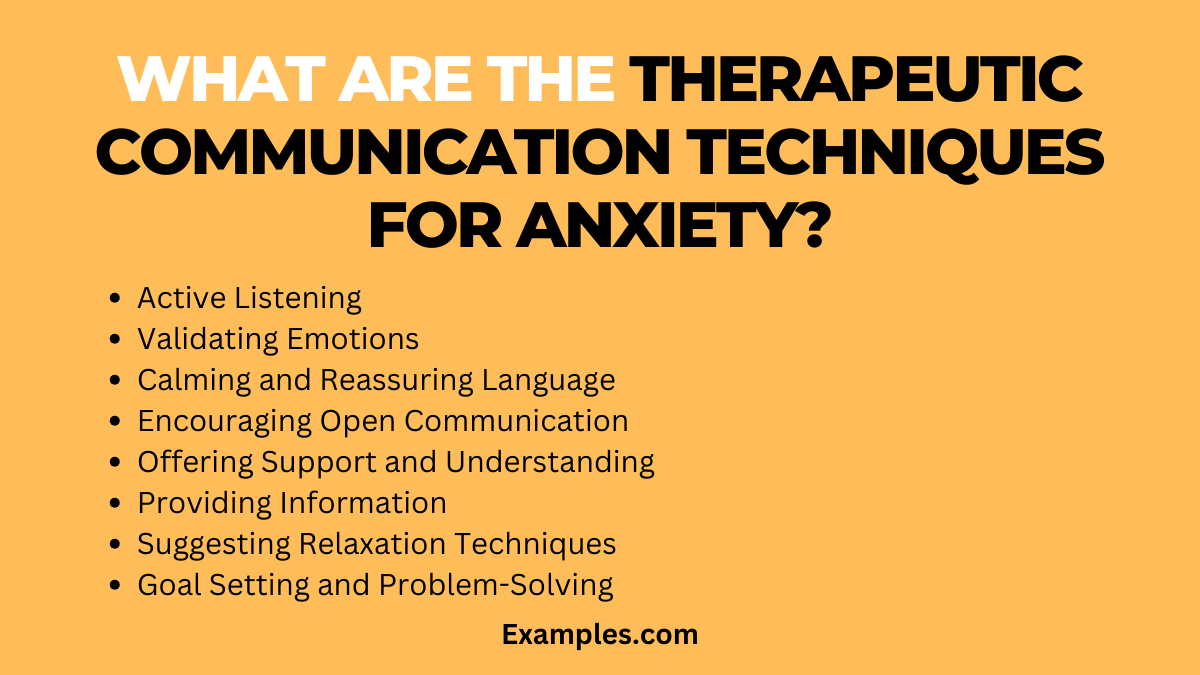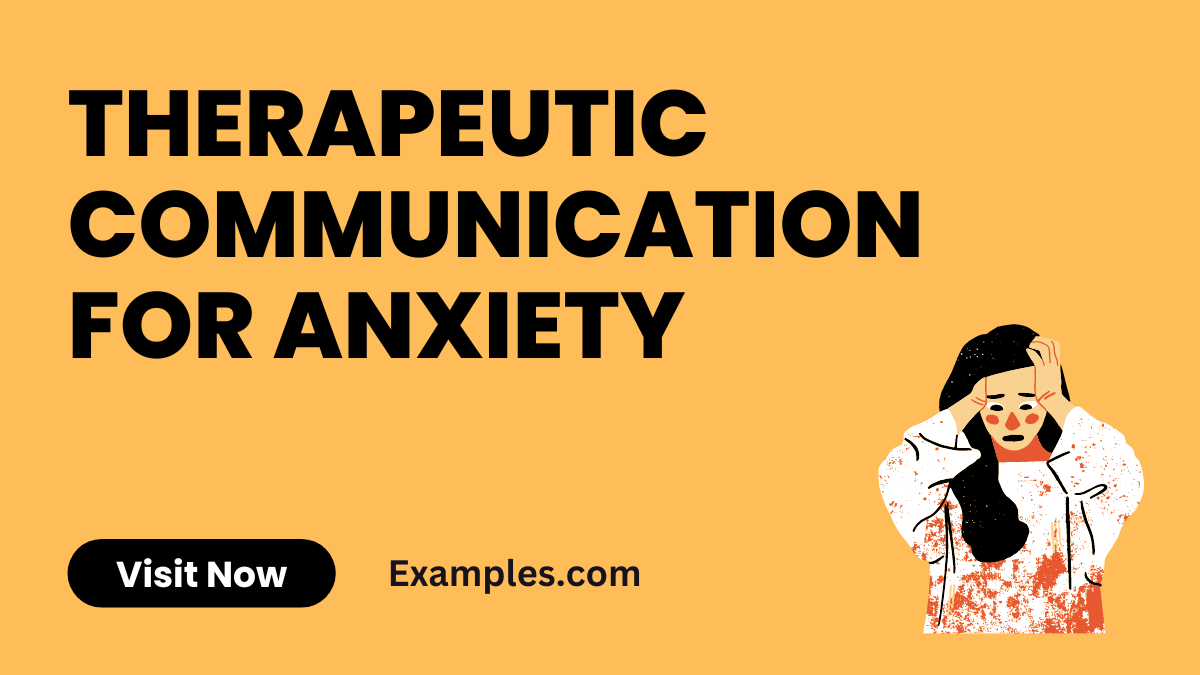19+ Therapeutic Communication for Anxiety Examples
Discover the transformative power of Therapeutic Communication for Anxiety. Delve into practical, empathetic communication techniques tailored for individuals experiencing anxiety. This guide, rich with real-world examples, offers healthcare professionals and caregivers effective strategies for fostering a supportive dialogue. Learn how to utilize active listening and empathetic responses to alleviate anxiety symptoms and promote mental well-being. Equip yourself with the skills to create a comforting and understanding environment for those in need of mental health support.
What is Therapeutic Communication for Anxiety?

Therapeutic communication for anxiety refers to specific communication techniques used to support individuals experiencing anxiety. This approach involves active listening, empathetic responses, and providing reassurance. It’s a way of talking to someone in a manner that helps to reduce their anxiety, making them feel understood and supported. The goal is to create a safe environment where the individual feels comfortable expressing their fears and concerns, enabling them to manage and cope with their anxiety more effectively. This type of communication is key in both clinical settings and personal interactions for supporting those with anxiety.
20 Therapeutic Communication for Anxiety Examples
Therapeutic communication is crucial for managing anxiety. This guide presents 30 powerful examples, each accompanied by explanations, to demonstrate how healthcare professionals can effectively communicate with anxiety patients. These examples illustrate key techniques like empathetic listening and reassuring language, showcasing the positive impact of therapeutic communication on anxiety management. These conversations are not just about what is said, but how it’s said, providing a roadmap for healthcare workers to offer comfort, understanding, and guidance to those struggling with anxiety.
- “I understand that this feels overwhelming for you right now.” This sentence acknowledges the patient’s feelings without judgment, offering a sense of understanding and empathy.
- “Let’s take this one step at a time together.” This approach breaks down challenges into manageable parts, reducing anxiety by focusing on immediate, achievable steps.
- “It’s okay to feel scared; many people in your situation would feel the same.” Validating the patient’s emotions normalizes their experience and fosters a supportive environment.
- “What can I do to make you feel more at ease?” This question shows a willingness to help and adapt to the patient’s needs, creating a collaborative approach to care.
- “Remember, your feelings are valid, but they don’t define you.” This statement helps the patient distinguish between their feelings and their identity, aiding in reducing the overwhelming impact of anxiety.
- “Let’s focus on what you can control right now.” This phrase helps direct the patient’s attention to actionable steps, reducing feelings of helplessness associated with anxiety.
- “Would you like to talk about what’s making you anxious?” Offering an opportunity for the patient to share their concerns promotes open communication and understanding.
- “I’m here with you, and you’re not alone in this.” Expressing presence and solidarity provides comfort and reassurance to the patient.
- “Take deep breaths; it can help calm your anxiety.” Suggesting practical, immediate techniques like breathing exercises empowers the patient to manage their anxiety symptoms.
- “Your progress is important, and I’m proud of how far you’ve come.” Recognizing and affirming the patient’s efforts in managing anxiety bolsters their confidence and motivation.
- “Let’s explore what triggers your anxiety.” This initiates a conversation to identify specific situations or thoughts that might be causing anxiety, helping in developing coping strategies.
- “How do you usually cope when you feel anxious?” Asking about the patient’s existing coping mechanisms acknowledges their efforts and opens the door to suggest improvements or alternatives.
- “It’s okay to feel anxious; let’s work through it together.” Validating the patient’s feelings while offering support can alleviate the stress of dealing with anxiety alone.
- “Would you like to try relaxation techniques?” Introducing relaxation methods like guided imagery or progressive muscle relaxation can be beneficial for patients struggling with anxiety.
- “Remember, your feelings are valid, but they don’t define you.” This statement helps the patient to understand that while their feelings are important, they are not solely defined by their anxiety.
- “Can you tell me more about how your anxiety affects you daily?” Encouraging the patient to discuss the impact of anxiety on their daily life provides insights for tailored therapeutic interventions.
- “It’s great that you’re seeking help for your anxiety.” Acknowledging the patient’s decision to seek help reinforces the positive step they have taken towards managing their condition.
- “Let’s discuss some strategies to manage anxiety in difficult situations.” This approach focuses on practical problem-solving and equipping the patient with tools to handle anxiety-provoking scenarios.
- “Would keeping a journal of your feelings help you?” Suggesting the patient keep a journal offers a way to express and track their emotions, aiding in therapy.
- “Remember, each small step you take is progress.” Encouraging the patient to recognize even minor achievements in managing anxiety can boost their morale and commitment to therapy.
What are the Therapeutic Communication Techniques for Anxiety?

Therapeutic communication techniques for anxiety involve specific strategies used by healthcare professionals to help individuals cope with and manage their anxiety. These techniques are centered around creating a supportive environment and using communication to alleviate the symptoms of anxiety.
Active Listening
Actively listening to patients’ concerns, fears, and experiences, showing understanding and empathy, is crucial in managing anxiety.
Validating Emotions
Acknowledging and validating the patient’s feelings without judgment helps in creating a trusting relationship.
Calming and Reassuring Language
Using calming words and reassurances can help to reduce anxiety levels and provide comfort.
Encouraging Open Communication
Inviting patients to share their thoughts and feelings openly helps in understanding the root of their anxiety.
Offering Support and Understanding
Showing support and understanding, emphasizing that the patient is not alone in their experience, is important in anxiety treatment.
Providing Information
Educating patients about anxiety, its symptoms, and coping strategies can empower them to manage their condition better.
Suggesting Relaxation Techniques
Introducing relaxation techniques like deep breathing or mindfulness can be effective in reducing anxiety symptoms.
Goal Setting and Problem-Solving
Helping patients set realistic goals and working on problem-solving strategies can give them a sense of control over their anxiety.
What are the Therapeutic Communication Skills for Anxiety?
Therapeutic communication skills are essential for healthcare professionals dealing with patients experiencing anxiety. These skills involve specific techniques that help in calming and reassuring patients, thereby reducing their anxiety. Effective use of these skills can significantly improve the patient’s comfort and willingness to participate in their care. These techniques are particularly important in managing patients with anxiety disorders, as they help in building trust, understanding the patient’s concerns, and providing the necessary support.
Providing Reassurance and Comfort
Reassuring the patient that they are in a safe and caring environment can alleviate feelings of anxiety. This involves using comforting words and a calm demeanor to provide a sense of security.
Encouraging Deep Breathing Exercises
Guiding patients through deep breathing exercises can be an effective way to reduce anxiety. This technique helps in relaxing the mind and body, promoting a sense of calm.
Active and Empathetic Listening
Showing empathy and actively listening to a patient’s concerns validates their feelings and helps in establishing a trusting relationship. This practice demonstrates understanding and compassion.
Using Positive Language
Positive language can have a calming effect on anxious patients. Phrases that encourage hope and optimism can help in shifting the patient’s focus from anxious thoughts to a more positive outlook.
Offering Gentle Distractions
Providing gentle distractions, such as talking about a patient’s interests or engaging in light-hearted conversation, can help in reducing anxiety by shifting focus away from stressors.
Guiding Visualization Techniques
Guiding patients through visualization or imagery techniques can be effective in managing anxiety. This involves asking the patient to imagine a peaceful and calming scenario, helping them to mentally escape from their anxious thoughts.
By applying these therapeutic communication skills, healthcare professionals can play a significant role in managing and reducing anxiety in their patients, leading to better healthcare experiences and outcomes.
How to Provide Therapeutic Communication for Anxiety?
Providing therapeutic communication for anxiety involves employing specific communication strategies to help patients navigate and manage their anxiety more effectively.
Developing Trust
Establishing a trustworthy and safe environment is essential for patients to feel comfortable sharing their anxieties.
Using Empathy
Showing empathy and understanding allows patients to feel heard and validated in their experiences.
Maintaining a Non-Judgmental Approach
A non-judgmental approach encourages patients to express their thoughts and emotions freely.
Encouraging Self-Expression
Encouraging patients to talk about their fears and concerns can provide insight into the triggers and nature of their anxiety.
Focusing on the Present
Guiding patients to focus on their current feelings and experiences helps in managing overwhelming anxiety.
Guiding Towards Self-Care
Advising on self-care practices that can help in managing anxiety, such as regular exercise or adequate sleep.
Reframing Negative Thoughts
Helping patients to reframe negative thoughts into more positive, realistic perspectives can reduce anxiety.
Collaborative Problem Solving
Working together with patients to identify problems and find practical solutions can empower them in their anxiety management journey.
Through these strategies, therapeutic communication serves as a key component in managing anxiety, offering not just medical solutions but also emotional and psychological support.
In conclusion, therapeutic communication is a vital tool in managing anxiety. It involves active listening, empathy, and a non-judgmental approach to encourage open dialogue and provide comfort to those struggling with anxiety. Techniques like focusing on the present, guiding towards self-care, and collaborative problem-solving empower patients in their journey toward managing anxiety effectively. For further insights on managing anxiety, Mayo Clinic offers valuable resources on Anxiety Disorders. Additionally, the American Psychological Association provides comprehensive information on Coping with Anxiety. These external links provide high-quality, authoritative content that can deepen understanding and offer practical guidance.



